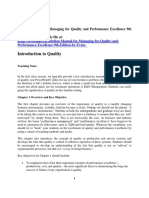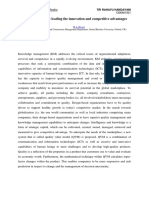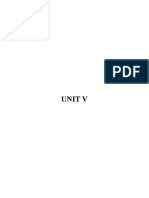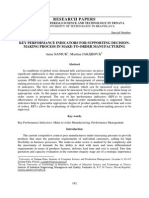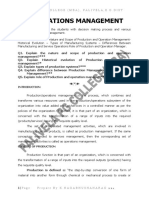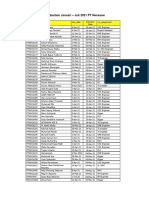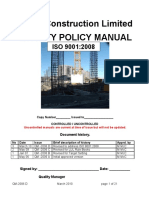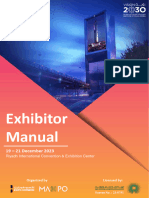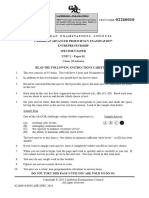Comparative Characteristics of TQM and Reengineering
Comparative Characteristics of TQM and Reengineering
Uploaded by
Andrei SerbanCopyright:
Available Formats
Comparative Characteristics of TQM and Reengineering
Comparative Characteristics of TQM and Reengineering
Uploaded by
Andrei SerbanOriginal Title
Copyright
Available Formats
Share this document
Did you find this document useful?
Is this content inappropriate?
Copyright:
Available Formats
Comparative Characteristics of TQM and Reengineering
Comparative Characteristics of TQM and Reengineering
Uploaded by
Andrei SerbanCopyright:
Available Formats
1) Milan Eri, Ph.D., FME Kragujevac, Sestre Janjic 6, e-mail: ericm@kg.ac.
yu
2) Miladin Stefanovi, Ph.D., FME Kragujevac, Sestre Janjic 6, e-mail: miladin@kg.ac.yu
COMPARATIVE CHARACTERISTICS OF TQM AND REENGINEERING
Milan Eri, Ph.D.
1)
, Miladin Stefanovi, Ph.D.
2)
Abstract: Basic characteristics of TQM and traditional reengineering concept are the framework
of this paper. Their comparison is conducted and their advantages and faults are emphasized.
Since the technological environment experiences constant technological changes in terms of
producing more with available resources and with new engineering and technological knowledge
or achieving the given production with less resources used, the question is: what kind of changes
are they. It is obvious that these changes are not always radical, but they lead to improvement of
performances. A concept that covered the working field between TQM and general reengineering
was originally defined for these changes. It was defined as "soft" reengineering.
Keywords: TQM, hard reengineering, soft reengineering
1. INTRODUCTION
In order to be concurrent and to provide self-
existence, small production companies are forced
to increase continuously the productivity and to
use the existing resources as much as possible.
This manifests through decrease in production
time, more efficient usage of material means and
optimization of material and information flow.
Dynamics of market environment reflects in
invention of new products, improvement and
changes of the existing products, that is, in
continuous expansion of demands regarding the
assortment and the quality of products, as well as
in reduction of costs and delivery deadlines,
resulting form the market research. A small
company will have a great business result, that is,
it will work well and achieve growth and
development, only if it produces a useful,
economical, likeable, thrifty, ecologically
convenient, competitive product, acceptable both
for the market and for the buyer.
A product, as the final instance of small company's
operation, has its own life cycle. In that cycle, the
product passes through several phases, shown in
diagram presented in Figure 1. The life cycle of the
product may be prolonged by its redesign
(restyling). The company achieves real,
competitive advancement if it develops new
product or products still in the phase of stable
production (Figure 2). In technological processes
that are the framework for product manufacture,
there is always a space for small changes and
improvements that may contribute to the decrease
in product's job time, increase in productivity,
decrease in machining costs, etc., and that may
monitor the product's life cycle, including the end
of stable production and sale. Another aspect of
changes in technological process is conditioned by
the changes on the product (design, quality, etc. -
the part of the curve of prolonged lifetime of the
product) that may also demand the changes in the
existing technological procedure of manufacture.
Both aspects of changes in technological process
may be achieved through "soft" and "hard" form of
reengineering.
It is obvious that there are two approaches to
improvement of technological processes. The first
approach means continuous improvement of
technological processes, redesign of the existing
technological processes or grouping of post-
processes/activities within the process.
Figure 1 Characteristic phases of the product's
life cycle [8]
The second approach means the total reengineering
of the technological processes. In other words, the
processes can be gradually improved, redesigned
to the maximum or changed from the ground up in
order to achieve the maximum efficiency. The
selection of the approach for overcoming the
individual problems depends on what is wrong and
what benefits are expected. The second approach
to process reengineering is conducted based on
significant change in demands regarding output
products or on significant change in technological
platform that sustains the production process.
Figure 2 Chart flow of competitive development
conservation [4]
In order to accelerate the appearance of new
products on the market, different engineering
philosophies, strategies, concepts and approaches
are applied in development segments of the
product's life cycle, with the aim to register and
remove the problems, errors and faults related to
the functionality and technology of the product as
soon as possible, before the production begins.
2. CONTINUAL IMPROVEMENT OF THE
PROCESS
Numerous meanings of the term TQM have a
consequence that the concept of TQM is unclear to
the users. It is described in different ways as "the
way", "philosophy", "culture", "approach", "new
religion", etc. It emerged from practice, but it is
evermore researched at the universities, as a
scientific management discipline. It is considered
that the total quality is still the best management
approach to simultaneous enthusiasm of the
customers, restructuring of organization, reduction
of costs, increase in productivity and profits and
long term sustainable development of organization,
even at the beginning of the 21
st
century [5].
TQM concept is based on leadership and
participation in which, all managers, all levels, all
employees are continuously the carriers of the
organizational culture values, all the time. Its basic
advantage is strict commitment to the customers.
Management sustains operational effectiveness,
creates stability and sustains a certain state in the
company. Leadership is oriented towards the
strategy: renewal of the process, changes and
future development. The good leadership is the key
to encouragement of the best in people and to
creation of the climate for creative thinking and
innovation. The basis of the TQM process is the
orientation towards the users and the achievement
of the balance in satisfaction of all interested
parties (customers, shareholders, stuff, partners
and society) with continuously growing
expectations. TQM is the dynamic concept of
continual improvement by generation of internal
changes as reply to rapid external changes.
Development, growth and changes may be
complementary factors as far as the dynamic
process of internal changes, answering to rapid
external changes, is established within the
company. This means continual, consistent,
preventive, innovative and proactive engagement
in improvement of the vision, mission, strategy
and practice of the company.
New structure of the company is based on the
process and systematic approach oriented towards
all users. Visible and invisible user needs must be
considered both strategically and systematically, as
a resource of ideas, based on which, results of
superior values are created.
To obtain success in application of TQM,
managers must select the methodology supported
by different tools and techniques, among which,
there are:
Improvement schemes PDCA, QFD,
Self-evaluation, Benchmarking,
Brainstorming, Quality groups,
Workshops, ...
Diagrams PROCESS FLOW, GANT,
ISHIKAWA, ...
Statistical tools SPC (7 tools and 7
new tools), SQC, ABC, FMEA, SWOT,...
The concept of TQM is considered as the best
multidisciplinary management approach for long
term and dynamic sustainable development of the
company. TQM values, methodology and tools are
the basis for application of modern organizational
models, from the models of excellence to the
integration of different standards and systems into
the strategy and practice of the company.
3. RADICAL IMPROVEMENT OF THE
PROCESS
The changes are a constant challenge to the
company. They are very distinct in technology,
where they are turbulent, with high degree of
uncertainty, but also in other domains: customers
conduct, competition, social relations, cultural
values, economic system, economic policy and
ecological demands. The companies face the
constant effort to improve competitiveness in
conditions of highly variable business environment
that carries a high level of uncertainty and risk.
Thus, a need for radical change of basic attitudes,
approaches and principles imposes itself and this is
called "a new company's philosophy". This effort,
a new assembly of ideas, procedures and principles
for ensuring the radical changes, is also called
reengineering and it implies such engagements in
organization and design of business processes that
bring essential, qualitative changes.
Reengineering of business processes implies a
systematic approach aimed at radical improvement
of the key business processes of the company.
Numerous modern approaches in the area of
management, quality, informatics, production, etc.,
have marked the 1990's. Reengineering
distinguished itself as a relevant concept of
conduction of radical organizational changes and
as a paradigm for business process redesign and
for creation of conditions for effective operation.
According to some research results, it has achieved
the fast and successful expansion, above all in
large companies in the Great Britain. In a way, this
is understandable, because reengineering have
opened new perspectives in organization
development. Besides, this concept of
organizational changes have gained certain media
attention and popularization as redesign of
business processes, as reengineering of business
processes or only as reengineering [7].
Practical experiences in the companies where
reengineering of the business processes was
conducted, have shown the following [9]: the
quality was improved by 84%, time to product
appearance was decreased by 75%, communication
was improved by 61%, development costs were
reduced by 54%, changes were reduced by 48%
and profit was increased by 35%. These results are
achieved, among other things, due to the
company's transition to information technologies,
which define new partnerships and which are used
to get closer to the customers. Then, it is necessary
to know the problems of the customers before
themselves, to know solution to their problems and
to offer it by Internet service.
The term "Business Process Redesign" was used
for the first time at MIT (Massachusetts Institute
of Technology), within the research program
"Management in the 1990's" conducted during
1984-1989. In the course of this research, it was
noted that many successful companies used the
information technology in more efficient manner
then traditional automation of administrative and
production sectors.
Regardless of the fact that the concept of "business
process redesign" appeared somewhat earlier, the
term "reengineering" was used for the first time in
the article "Reengineering work: Don't Automate,
Obliterate", published by Michael Hammer in
"Harvard Business Review", in 1990. Hammer is
nowadays considered as the founder of
reengineering concept. Together with Jammes
Champy, he published the book "Reengineering
the Corporation - A Manifesto for Business
Revolution" (in 1993), where they more
completely explained the concept and the ideas of
reengineering.
A large number of definitions of reengineering
exist in the literature. All of them mainly rest upon
the definition given by Michael Hammer and
Jammes Champy: "Reengineering is fundamental
revision and radical redesign of business processes
in order to achieve dramatic improvement in
critical measurable performances of the company,
like costs, quality, services or speed" [2] (Figure
3).
Figure 3 Key parameters in focus of reengineering
In addition to already mentioned definition given
by Hammer and Champy, there is a set of other
definitions given by individual authors or teams
engaged in research of the concept of
reengineering. Thus, Thomas Davenport (1993)
defines reengineering as "revolutionary new
approach that uses information technology for
dramatic improvement of business performances",
while Butter Cox (1991) defines it as "the way of
transforming business based on abolition of
traditional ways of business with information
technology in a key role".
4. Similarities and differences between
reengineering and TQM
TQM (Total Quality Management) is described as
long term, intensive effort to transform all parts of
the company in order to create products and
services that are best in accord with needs,
expectations and demands of the customers. In the
broadest sense, TQM represents continuous,
incremental improvement of the activities that
includes all members of the company, managers
and stuff in totally integrated effort to improve
performances at all levels [1]. Improvement is
aimed at satisfaction of all goals like quality, costs,
organization, mission, etc.
Reengineering means actions in organization and
system design that provide essential and
qualitative changes in systems operation. It is
based on radical horizontal restructure of
organization in order to improve performance of
the key processes, to obtain visible improvements
in short term. Reengineering technique was
developed at the beginning of the 1990's and, at
the start, it was considered that its application
meant designing the organization from nothing.
However, since it was shown that a small number
of companies might allow themselves that luxury,
reengineering has directed itself to introduction of
improvements in basic processes, as well as on
attempts to define adequately real needs for
engagement of management and stuff in their
realization, based on criteria for maximal
satisfaction of customers or users.
Market increase by 20%, income increase per
employee by 15-30%, reduction of development
stage of the product by 30-50% and reduction of
time for preparation process and production (from
creating the order form to delivery) by three times
are obtained results of reengineering in companies
like "Hewlett-Packard", "Lloyd", "Ball Atlantic"
and "General Electric". However, practical
experience shows that almost 50 to 70% (typically)
of actions taken in reengineering do not give
results specified for some definite term.
Considering the promises and price, this very high
degree of failure is extremely problematical and
arouses a large number of questions. Why is the
success rate so small? Does the reason lie in over
planning or in bad judgement of which processes
should be changed or in the human factor that is
not ready to accept changes? It may be
immediately emphasized that the odds for success
are primarily connected to the confidence of the
leading management in success.
Both concepts incline towards improvement of
company's performances in order to obtain as good
position on the market as possible and to create
competitive advantages. Both, reengineering and
TQM, bring changes to the company. However,
TQM means incremental changes conducted over a
longer period that lead to gradual improvement of
performances. Such changes are frequently not
enough to provide competitive advantage for the
company in environment that can change a lot
faster. The essence of reengineering reflects
exactly in the speed of conducting the changes that
are dramatic and radical. TQM is oriented on the
existing processes, while the old processes are
conducted in a new way. Reengineering mostly
leads to the changes in organizational structure,
while TQM is directed towards the improvement
of performances within the existing organization.
Basic similarities between reengineering and TQM
are in orientation towards the processes, while the
initiative for introduction is given, in both cases,
by the top management, and, in both cases,
responsibilities and permissions as well as needs
for education and training are being nominated.
Reengineering of business processes and TQM
methodology have drastic differences. Firstly,
continuous and small improvements are gained by
TQM, while reengineering brings abrupt and
drastic improvements. TQM demands involvement
of all stuff, while reengineering demands team
work. TQM demands small investments, while
reengineering demands large ones. TQM demands
inclusion of all processes, while reengineering
includes separate critical processes. Finally, it must
be emphasized that TQM means voluntarily
involvement of the stuff, while reengineering is
forced under command.
Some theoreticians connect the term improvement
to TQM concept, while the term innovation is a
synonym for reengineering [6]. Thus, TQM and
reengineering processes are observed as two
separate processes, which is considered as being
wrong by other theoreticians that state that the
organization cannot constantly advance through
improvements and that innovations and
reengineering must be introduced. This second
group of theoreticians think that one should
innovate, then improve, then innovate again and
improve again. This applies to the processes, to the
products and to the total operation. Total quality is
the goal, TQM is the mean, and techniques and
reengineering are given for achievement of total
quality. TQM may serve for adjustment of the
processes between the two radical changes. This
means that continual and radical improvements are
periodically interchanged (Figure 4).
Figure 4 Dependence of the improvement level on
time [6]
A new, derived concept is introduced as a
compromise between these two concepts "soft"
reengineering. Soft reengineering means
traditional interpretation of reengineering or the
"hard" reengineering mixed with TQM. Soft
engineering carries evolutional, that is continual
changes. It is process directed. The carriers of the
processes have the responsibility for changes and
the process is project oriented. Continuous, not
radical improvement is its basic characteristic.
Comparative characteristics of TQM, soft
reengineering and hard reengineering are presented
in Table 1.
Table 1 Comparative characteristics of TQM, soft reengineering and hard reengineering [3]
Factors TQM Soft reengineering Hard reengineering
Responsibility for
application
Top management Carrier of the process Top management
Initiative for change Top - Down Top - Down Top Down
Changes in
management structure
Marginal Small Radical
Type of changes
Evolutional better
way of conducting the
existing work
Evolutional better way
of conducting the
existing work
Revolutionary new
way of conducting
work
Method
Improvement of the
existing process
addition of new value
in the existing
processes
Improvement of the
existing process
addition of new value in
the existing processes
Checking of the
justification of the
existing processes
and functions
fundamental change
in process
Area Complete organization Key processes Key processes
Role of technology Traditional support Traditional support
Technology as a
basic actuator
Duration Long term oriented Project oriented Project oriented
Soft reengineering of the process should enable
improvement of quality, reduction of costs,
reduction of process execution time, elimination of
unnecessary activities, comfortable working
atmosphere and it should define broad
responsibilities of stuff. Conducting of the soft
reengineering of the process dictates
corresponding changes in organization,
technology, business and informatics.
Reengineering, as a concept, has a "soft" and a
"hard" component or form. The first form is rather
the way of thinking like "If something is wrong
with my system, I will not look for an offender,
but I will fix the system". It relies, first, on human
resources, on motivation, knowledge, creativity,
inventiveness, innovation, teamwork, etc. The
second form is "fundamental change" and, as far as
technological systems are concerned, it includes
modern and expensive technical solutions like
CNC machines, industrial robots/manipulators,
graphical stations, computers, software, etc.
Constant improvements of the system make
evolution, while fundamental, drastic, radical
changes make revolution. Evolution is more safe
way, without any risk (small changes). When the
pressure of the environment (market) becomes too
big and when gradual changes do not help, a
radical change is necessary.
CONCLUSION
The shown concepts enable the removal of the
weak spots, optimization, innovations and
rationalization of the processes. They differ in
range (scope) of the intervention on the process, by
intervention duration, by results and by amount of
risk. Regardless of the mode, they should enable
finding and introduction of new, better solutions
that will provide more effective and efficient
production or operation.
REFERENCES
[1] Arsovski S., Ruti D., Tehnoloka
transformacija preduzea primenom koncepta
reinenjeringa i agilnih proizvodnih sistema,
Upravljanje kljunim aspektima
transformacije preduzea, monografija,
Ekonomski fakultet, Kragujevac, 1998.
[2] Burke G., Peppard J., "Examining Process
Reengineering", Kogan Page, 1995.
[3] Eri M., Model reinenjeringa tehnolokih
procesa malih preduzea, doktorska
disertacija, Mainski fakultet Kragujevac,
2007.
[4] Longenecker J., Moore C., Pettz W., "Small
Business Management", Thomson Learning,
Mason, Ohio, 2003.
[5] Heleta M., TQM - Model izvrsnosti
integrisani menadment sistemi i model
izvrsnosti, Izdanje EDUCTA, Beograd, 2004.
[6] Perovi M., "Menadment informatika
kvalitet", CIM centar - Mainski fakultet,
Kragujevac, 1999.
[7] Stein R., "Re-engineering the manufacturing
system Applying the theory of constraints",
Marcel Dekker, Inc., New York, 1996.
[8] Todi V., "Projektovanje tehnolokih
procesa", Fakultet tehnikih nauka, Novi Sad,
2004.
[9] Veljovi A., "Kompjuter i kvalitet, ISO 9000: 2000
procesni pristup", Savez inenjera i tehniara
Jugoslavije, Beograd, 2001.
You might also like
- Solution Manual For Managing For Quality and Performance Excellence 9th Edition by EvansDocument30 pagesSolution Manual For Managing For Quality and Performance Excellence 9th Edition by Evansa229715647100% (1)
- User Manual For UV210C PDFDocument19 pagesUser Manual For UV210C PDFAndrei SerbanNo ratings yet
- Dying DailyDocument3 pagesDying DailyAnonymous AHIfjTqLFlNo ratings yet
- Comparative Characteristics of TQM and ReengineeringDocument5 pagesComparative Characteristics of TQM and ReengineeringMilan KolarevicNo ratings yet
- Process-Reengineering - HTML: Photo By: IqonceptDocument7 pagesProcess-Reengineering - HTML: Photo By: IqonceptMaryouma DocNo ratings yet
- Week 9 - Lesson 7 - Process ManagementDocument8 pagesWeek 9 - Lesson 7 - Process ManagementJoal lendon AalaNo ratings yet
- An Engineering Approach To An Integrated Value Proposition Design Framework C. Van Der Merwe, A. Van Rensburg & C.S.L. SchutteDocument16 pagesAn Engineering Approach To An Integrated Value Proposition Design Framework C. Van Der Merwe, A. Van Rensburg & C.S.L. SchuttejNo ratings yet
- Ingeniero de ProductoDocument27 pagesIngeniero de ProductoJuan Diego Arroyave SernaNo ratings yet
- TotalQualityManagementTQMANeedofIndustryforQualityProductDocument8 pagesTotalQualityManagementTQMANeedofIndustryforQualityProduct072- Krutarth PatelNo ratings yet
- Design For Utility, Sustainability and Societal Virtues: Developing Product Service SystemsDocument8 pagesDesign For Utility, Sustainability and Societal Virtues: Developing Product Service SystemsEduardo DiestraNo ratings yet
- Chapter 7Document3 pagesChapter 7Cathy MamigoNo ratings yet
- TQM-M1 2024Document12 pagesTQM-M1 2024zapantamiles2No ratings yet
- Operations MGMT Lecture Note (Chapter 3) MLTDocument42 pagesOperations MGMT Lecture Note (Chapter 3) MLTnatiNo ratings yet
- Quality Control Lecture 3 & 4Document45 pagesQuality Control Lecture 3 & 4Turyamusiima CleverNo ratings yet
- Total Quality Management (TQM) and Business Process Re-Engineering (BPR)Document24 pagesTotal Quality Management (TQM) and Business Process Re-Engineering (BPR)Nazish Sohail50% (2)
- 1 - Introduction For OSCM and ManagementDocument29 pages1 - Introduction For OSCM and ManagementMuskan PoptaniNo ratings yet
- SIX SIGMA in EducationDocument17 pagesSIX SIGMA in EducationVadher AmitNo ratings yet
- Quality Revolution: Leading The Innovation and Competitive AdvantagesDocument4 pagesQuality Revolution: Leading The Innovation and Competitive AdvantagesHwan Tae RiNo ratings yet
- Solution Manual For Managing For QualityDocument30 pagesSolution Manual For Managing For QualityKissi MartinNo ratings yet
- THOUGHT CHPTER SEVEN ThoughtDocument24 pagesTHOUGHT CHPTER SEVEN ThoughtJulianNo ratings yet
- I - Introduction Total Quality Management (TQM) Is A Comprehensive Management Approach That Originated inDocument6 pagesI - Introduction Total Quality Management (TQM) Is A Comprehensive Management Approach That Originated inJennelyn Saupi BantalaNo ratings yet
- Gurus of Total Quality Management: ObjectivesDocument15 pagesGurus of Total Quality Management: ObjectivesKaryll JustoNo ratings yet
- Concepts of ProductivityDocument7 pagesConcepts of ProductivityoodaiNo ratings yet
- Lesson 10Document28 pagesLesson 10Tirusameer YarlagaddaNo ratings yet
- Question # 1 (A) Define Scope and Significance of Operation ManagementDocument11 pagesQuestion # 1 (A) Define Scope and Significance of Operation ManagementHuzaifa Khalil100% (1)
- MasteralDocument9 pagesMasteralMARY ROSE YASENo ratings yet
- Critical Book About Operations ManagementDocument40 pagesCritical Book About Operations ManagementEsra Sitanggang0% (1)
- The Integration of TQM and BPRDocument18 pagesThe Integration of TQM and BPRdawit melkamuNo ratings yet
- TQM Im Chap 1Document8 pagesTQM Im Chap 1salamat lang akinNo ratings yet
- 1033-TQM-KIA MotorsDocument23 pages1033-TQM-KIA MotorsMuhammad NaveedNo ratings yet
- Total Quality Management TQM and Business Process Re Engineering BPRDocument24 pagesTotal Quality Management TQM and Business Process Re Engineering BPRdawit melkamuNo ratings yet
- MNGT3108 - M5-Product and Service DesignDocument7 pagesMNGT3108 - M5-Product and Service DesignMa. Angela RosauroNo ratings yet
- The Degree To Which Banks Are Committed To Applying The Dimensions of Total Quality With Regards To Serving Their ClientsDocument18 pagesThe Degree To Which Banks Are Committed To Applying The Dimensions of Total Quality With Regards To Serving Their ClientsAlexander DeckerNo ratings yet
- Final Assignment PMQDocument13 pagesFinal Assignment PMQDang Mai PhuongNo ratings yet
- Kaizen Method in Production Management: January 2011Document9 pagesKaizen Method in Production Management: January 2011Lê Thanh PhongNo ratings yet
- Production, Operasi, SCM For Grando, SecchiDocument4 pagesProduction, Operasi, SCM For Grando, SecchiAYU SAPITRINo ratings yet
- 1 s2.0 S1877042813005673 MainDocument10 pages1 s2.0 S1877042813005673 MainAmir BakhshiyanNo ratings yet
- Business Process ReengineeringDocument21 pagesBusiness Process ReengineeringAvantika BakshiNo ratings yet
- Five Different Models or Theories of ChangeDocument9 pagesFive Different Models or Theories of Changemjenks5No ratings yet
- Production Mnagement Short ReportDocument5 pagesProduction Mnagement Short Reportayon100% (1)
- Unesco - Eolss Sample Chapters: Principles and Tools of Total Quality ManagementDocument0 pagesUnesco - Eolss Sample Chapters: Principles and Tools of Total Quality ManagementKin SkyeNo ratings yet
- Topic 2 Cost of QualityDocument13 pagesTopic 2 Cost of Qualityjamesbrooke662No ratings yet
- Module 1 Notes - 18ME734.Document17 pagesModule 1 Notes - 18ME734.SANTOSH0% (1)
- CHAPTER 1 - Overview of TQMDocument15 pagesCHAPTER 1 - Overview of TQMakzhNo ratings yet
- Managing Change in Quality OrientedDocument12 pagesManaging Change in Quality OrientedsanjmazNo ratings yet
- Sustainable Manufacturing Process & Its Effects: Prof A N Mullick National Institute of Technology DurgapurDocument17 pagesSustainable Manufacturing Process & Its Effects: Prof A N Mullick National Institute of Technology DurgapurHimansu GoswamiNo ratings yet
- Research Papers: Key Performance Indicators For Supporting Decision-Making Process in Make-To-Order ManufacturingDocument9 pagesResearch Papers: Key Performance Indicators For Supporting Decision-Making Process in Make-To-Order Manufacturings3254No ratings yet
- Operations Management: Palivela PG College (Mba), Palivela, E.G.DistDocument60 pagesOperations Management: Palivela PG College (Mba), Palivela, E.G.DistssskcollegeNo ratings yet
- Operations Management1Document60 pagesOperations Management1ssskcollege100% (1)
- The Institution of Engineers (India) : Vijayawada Local CenterDocument8 pagesThe Institution of Engineers (India) : Vijayawada Local CentervenkateshmukharjiNo ratings yet
- Total Quality Management Unit 1Document15 pagesTotal Quality Management Unit 1Vicky Vignesh Thanga PandiNo ratings yet
- 5TQMDocument25 pages5TQMnityansh.bhuNo ratings yet
- Project Report ReflectionDocument3 pagesProject Report ReflectionDaniel CrawfordNo ratings yet
- Product and Service DesignDocument46 pagesProduct and Service DesignKim TaengoossNo ratings yet
- Sustainable Operation ManagementDocument8 pagesSustainable Operation ManagementRupesh Paudel 2138No ratings yet
- Quality Management MINI Project OnDocument11 pagesQuality Management MINI Project OnGok L Tuna100% (1)
- Operations ManagementDocument43 pagesOperations ManagementViraja GuruNo ratings yet
- Project Topic: The Impact of Total Quality Management On Organizational Performance. (A Case Study of Fine Coat Limited)Document73 pagesProject Topic: The Impact of Total Quality Management On Organizational Performance. (A Case Study of Fine Coat Limited)AdityaMukherjeeNo ratings yet
- Just in TimeDocument7 pagesJust in TimePraneit KhotNo ratings yet
- FLEXIBILIDADEDocument1 pageFLEXIBILIDADEBene ViolanteNo ratings yet
- Based on scientific advancement theoryDocument16 pagesBased on scientific advancement theorycrjk10550No ratings yet
- Evolving Management Practices: Navigating the Modern Business LandscapeFrom EverandEvolving Management Practices: Navigating the Modern Business LandscapeNo ratings yet
- User Manual For UV210CDocument19 pagesUser Manual For UV210CAndrei SerbanNo ratings yet
- Calendar SaptamanalDocument2 pagesCalendar SaptamanalAndrei SerbanNo ratings yet
- Program Saptamanal: IntalniriDocument2 pagesProgram Saptamanal: IntalniriAndrei SerbanNo ratings yet
- Business Process Reengineering MBA III 444688019Document3 pagesBusiness Process Reengineering MBA III 444688019Andrei SerbanNo ratings yet
- 17 19MB15 EngDocument28 pages17 19MB15 EngAndrei SerbanNo ratings yet
- Host Entrepreneur: Get Involved in Just 3 Steps!Document2 pagesHost Entrepreneur: Get Involved in Just 3 Steps!Andrei SerbanNo ratings yet
- SysStruc 11 Conference - Univ Eftimie Murgu ResitaDocument2 pagesSysStruc 11 Conference - Univ Eftimie Murgu ResitaAndrei SerbanNo ratings yet
- Change Managementknowing Doing Gap Aaangehrn InseadDocument4 pagesChange Managementknowing Doing Gap Aaangehrn InseadAndrei SerbanNo ratings yet
- Class 12 Economics Sample Paper Set 2Document31 pagesClass 12 Economics Sample Paper Set 2Artham ResourcesNo ratings yet
- AnimalDocument27 pagesAnimaljessalyn iladaNo ratings yet
- KIM - Kotak Equity Opportunities FundDocument18 pagesKIM - Kotak Equity Opportunities Fundsomnaththorat2122No ratings yet
- Class 12 - Physics - NucleiDocument28 pagesClass 12 - Physics - NucleiRohit RNo ratings yet
- Purewal-Haini2021 Article Re-examiningTheEffectOfFinanciDocument23 pagesPurewal-Haini2021 Article Re-examiningTheEffectOfFinancihajarNo ratings yet
- Margaret L. King, Ed. and TransDocument2 pagesMargaret L. King, Ed. and TransMario CplazaNo ratings yet
- List Induction - 2021Document4 pagesList Induction - 2021Satria Azizul HakimNo ratings yet
- Elective 1 Concept of Family: The Parents: Group 2Document13 pagesElective 1 Concept of Family: The Parents: Group 2Lorenzo DonqueNo ratings yet
- Romania - The New Outsourcing Valley of EuropeDocument12 pagesRomania - The New Outsourcing Valley of EuropeThank_me_laterNo ratings yet
- LIT 100 - Reading Package II PDFDocument100 pagesLIT 100 - Reading Package II PDFAhmet Saim Yılmaz100% (1)
- Derlin Construction Limited Quality Policy Manual: Document HistoryDocument30 pagesDerlin Construction Limited Quality Policy Manual: Document HistoryAdams Bruno100% (1)
- Isaiah 53:7Document6 pagesIsaiah 53:7Elisha ben AbuyaNo ratings yet
- RRC Setup FailuresDocument3 pagesRRC Setup FailuresBiswajit MohantyNo ratings yet
- Land Law SeminarsDocument2 pagesLand Law SeminarsLord BobNo ratings yet
- Loan Amortization Schedule1Document8 pagesLoan Amortization Schedule1Keshav VarpeNo ratings yet
- IDSE Exhibitor Manual 2023Document16 pagesIDSE Exhibitor Manual 2023fathabNo ratings yet
- BSNL TariffDocument52 pagesBSNL TariffmalaychandaNo ratings yet
- Steel Industry IndonesiaDocument4 pagesSteel Industry IndonesiaBerlin WijayaNo ratings yet
- IP InfusionDocument4,190 pagesIP InfusionTito CamposNo ratings yet
- 2024 Spec p1Document10 pages2024 Spec p1Abby GailNo ratings yet
- Intercompany Inventory Transactions: Mcgraw-Hill/Irwin © 2008 The Mcgraw-Hill Companies, Inc. All Rights ReservedDocument22 pagesIntercompany Inventory Transactions: Mcgraw-Hill/Irwin © 2008 The Mcgraw-Hill Companies, Inc. All Rights ReservedFarhan Osman ahmedNo ratings yet
- PWC H1 2020 Global Crypto M&A Fundraising Report Oct 2020 PDFDocument26 pagesPWC H1 2020 Global Crypto M&A Fundraising Report Oct 2020 PDFForkLogNo ratings yet
- ITF - SIWES Report Sheet - 1584379696Document2 pagesITF - SIWES Report Sheet - 1584379696Animonga HajimeNo ratings yet
- Huf Gift Creation Partition DeedsDocument6 pagesHuf Gift Creation Partition DeedsshashannkkNo ratings yet
- Brochure y Credenciales Onddi LatamDocument28 pagesBrochure y Credenciales Onddi LatamGuillermo ReyNo ratings yet
- The Reinstitution of Death Penalty in The PhilippinesDocument4 pagesThe Reinstitution of Death Penalty in The PhilippinesLindy Lorraine AsidoyNo ratings yet
- MBA-FPX5016 LeslieCrystal 3-1Document14 pagesMBA-FPX5016 LeslieCrystal 3-1littlepinkdemon333No ratings yet
- Social Media AuditDocument8 pagesSocial Media Auditapi-559133010No ratings yet
- Civics Ethical Education: Teacher Guide Grade 9Document184 pagesCivics Ethical Education: Teacher Guide Grade 9Hani Taye87% (15)
